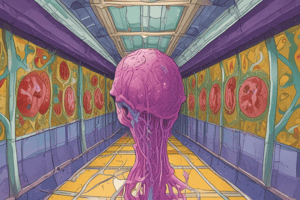Podcast
Questions and Answers
Which type of necrosis is characterized by the presence of lysosomal enzymes released from dead polymorphs?
Which type of necrosis is characterized by the presence of lysosomal enzymes released from dead polymorphs?
- Coagulative necrosis
- Liquefactive necrosis (correct)
- Caseous necrosis
- Fat necrosis
What is the primary cause of liquefactive necrosis in the CNS?
What is the primary cause of liquefactive necrosis in the CNS?
- Trauma to the adipose tissue
- Presence of caseous material
- High lipid and fluid content (correct)
- Release of pancreatic lipase
Which of the following is NOT a characteristic of apoptosis?
Which of the following is NOT a characteristic of apoptosis?
- Formation of apoptotic bodies
- Inflammation in the surrounding tissue (correct)
- Cell shrinkage
- Nuclear fragmentation
What is the key difference between traumatic and enzymatic fat necrosis?
What is the key difference between traumatic and enzymatic fat necrosis?
Which of the following is a physiological cause of apoptosis?
Which of the following is a physiological cause of apoptosis?
What is the primary cause of cloudy swelling?
What is the primary cause of cloudy swelling?
Which of these is NOT a type of irreversible cell injury?
Which of these is NOT a type of irreversible cell injury?
What is the hallmark characteristic of liquefactive necrosis?
What is the hallmark characteristic of liquefactive necrosis?
What is the difference between hydropic change and cloudy swelling?
What is the difference between hydropic change and cloudy swelling?
What is the correct sequence of nuclear changes during necrosis, starting with the earliest event?
What is the correct sequence of nuclear changes during necrosis, starting with the earliest event?
Which of these is NOT a common cause of cell injury?
Which of these is NOT a common cause of cell injury?
Which type of necrosis is characterized by a cheesy appearance of the necrotic tissue?
Which type of necrosis is characterized by a cheesy appearance of the necrotic tissue?
What is the primary mechanism behind fatty change in cells?
What is the primary mechanism behind fatty change in cells?
Flashcards
CNS Infarction Liquefaction
CNS Infarction Liquefaction
Liquefaction in CNS infarction is caused by high lipid and fluid content.
Pyogenic Abscess
Pyogenic Abscess
A pyogenic abscess is liquefied tissue due to lysosomal enzymes from dead polymorphs (pus cells).
Caseation Necrosis
Caseation Necrosis
Caseation necrosis is semi-solid, cheese-like tissue necrosis, seen in tuberculosis.
Enzymatic Fat Necrosis
Enzymatic Fat Necrosis
Signup and view all the flashcards
Apoptosis
Apoptosis
Signup and view all the flashcards
Hypoxia
Hypoxia
Signup and view all the flashcards
Reversible Injury
Reversible Injury
Signup and view all the flashcards
Cloudy Swelling
Cloudy Swelling
Signup and view all the flashcards
Necrosis
Necrosis
Signup and view all the flashcards
Coagulative Necrosis
Coagulative Necrosis
Signup and view all the flashcards
Liquefactive Necrosis
Liquefactive Necrosis
Signup and view all the flashcards
Fatty Change
Fatty Change
Signup and view all the flashcards
Immunologic Reactions
Immunologic Reactions
Signup and view all the flashcards
Study Notes
Cell Injury Overview
- Cell injury is the damage to cells, resulting in various morphological alterations.
- Injury can be reversible or irreversible.
- Reversible injury leads to degeneration, while irreversible injury results in necrosis or apoptosis.
Types of Cell Injury
- Hypoxia: Insufficient oxygen supply, caused by ischemia (poor blood flow) or inadequate oxygenation/anemia.
- Physical agents: Trauma, heat, cold, radiation, electric shock.
- Chemical agents and drugs: Therapeutic drugs, poisons, environmental pollutants, alcohol.
- Infectious agents: Viruses, bacteria, fungi, parasites.
- Immunologic reactions: Autoimmune diseases.
- Genetic derangements.
- Nutritional imbalances: Protein-calorie deficiency, vitamin deficiencies or excesses.
Reversible Cell Injury (Degeneration)
- Cloudy swelling (Hydropic change): Earliest change, characterized by water accumulation within cells, particularly seen in liver and myocardial cells.
- Hydropic (ballooning or vacuolar change): Similar to cloudy swelling, but more severe and advanced, with increased water accumulation causing swelling and vacuole formation within the cytoplasm.
- Fatty change: Occurs in hypoxic or toxic injury, affecting cells involved in fat metabolism like liver and myocardial cells. Lipids accumulate as empty vacuoles in the cytoplasm.
Irreversible Cell Injury (Necrosis)
- Necrosis: Death of a group of cells, causing inflammation in surrounding tissues.
- Morphological Changes:
- Nuclear changes:
- Pyknosis: Nuclear shrinkage.
- Karyorrhexis: Fragmentation of the nucleus.
- Karyolysis: Disappearance of the nucleus's basophilia (staining).
- Cytoplasmic changes: Loss of cell border and eventually structural loss of the necrotic tissue.
- Nuclear changes:
- Types of Necrosis:
- Coagulative: Resulting from ischemia (insufficient blood supply); necrotic tissue appears firm and dry, missing cellular detail under microscopy.
- Liquefactive: Necrotic tissue appears liquid due to high lipid and fluid content (like in CNS infarction), or enzymatic lysis (like in pyogenic abscesses).
- Caseous: Begins as coagulative necrosis, then proceeds to slow partial liquefaction; necrotic tissue appears semi-solid, yellowish, and cheese-like (casein), often seen in tuberculosis.
- Fat necrosis: Two types:
- Traumatic: Trauma to adipose tissue releasing intracellular fat triggers an inflammatory response, leading to fibrosis. Commonly observed in the breast.
- Enzymatic: Leakage of pancreatic lipase in acute pancreatitis, causing fat breakdown; glycerol is absorbed, fatty acids combine with Ca+, resulting in white deposits and fibrosis.
Irreversible Cell Injury (Apoptosis)
- Apoptosis: Programmed cell death, energy-dependent.
- Morphological changes:
- Cell shrinkage with intact plasma membrane.
- Nucleus shrinkage and fragmentation.
- Formation of apoptotic bodies (membrane-bound fragments of the cell).
- Removal of apoptotic cells and bodies by macrophages.
- No inflammation in surrounding tissues.
- Causes:
- Physiological: Normal cell turnover, embryonic development, endocrine-dependent tissue involution (e.g., menstrual cycle).
- Pathological: Radiation injury, cell death by cytotoxic lymphocytes, liver cells in viral hepatitis, pathological atrophy.
Studying That Suits You
Use AI to generate personalized quizzes and flashcards to suit your learning preferences.




